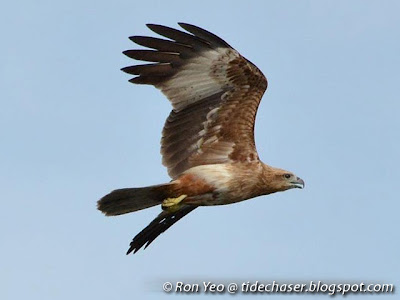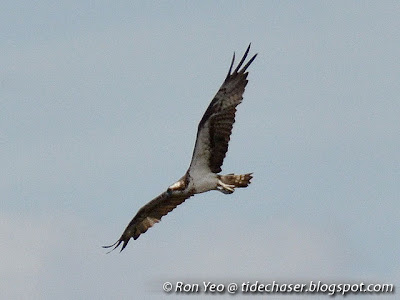Eagles, falcons, kites and other diurnal raptors (phylum Chordata, subphylum Vertebrata, superclass Tetrapoda, class Aves, order Falconiformes) usually have big hooked bills, strong legs, and long sharp talons on the toes. They generally have excellent eyesight and are very strong flyers. Most are soaring birds, being able to maintain their flight without flapping their wings, but instead ride on the currents created by rising hot air. They are also called birds of prey, since most of them hunt small animals to feed on, though many are also carrion feeders.
Here are some of the raptors that can be seen in Singapore, though some of the photos below were taken in other countries.

The Brahminy Kite (Haliastur indus) is one of the most commonly seen resident raptors in Singapore, and can be seen all over the main island and also the surrounding offshore islands. It can grow to about 50cm long, and the adults can be easily recognised by the chestnut coloured body and wings with a white head and breast. The above photo was taken in Malaysia.

The juveniles, however, are brownish. Brahminy Kites scavenge or steal food from other predatory birds, but sometimes hunt for their own prey as well. The above photo was taken in Malaysia.

The Black-winged Kite (Elanus caeruleus) is another common resident raptor, though it prefers open habitats and thus is less commonly seen. Growing to about 30cm long, it can be recognised by the black shoulder, black mask, white underside and greyish back. This raptor has a habit of hovering in mid-air while hunting.

The White-bellied Sea Eagle (Haliaeetus leucogaster) is a common resident raptor that can get to over 80cm long, making it the largest resident raptor as well.

The adult White-bellied Sea Eagles have a white head and grey back. The underside is mostly white, except the black flight feathers on the wings.

The juvenile White-bellied Sea Eagles are brownish. They are usually found near water bodies, feeding mostly on fish, but sometimes other smaller animals and carrion as well.

The Grey-headed Fish Eagle (Ichthyophaga ichthyaetus) is a rare resident raptor. It can get to about 75cm long, and the adults can be recognised by the grey head, brown breast, white belly, and white tail feathers with black tips. It is found in forested areas near water bodies. This eagle feeds on fish and sometimes other small animals.

The Changeable Hawk Eagle (Spizaetus cirrhatus) is an uncommon resident raptor which gets its common name from its variable plumage. There are dark and pale morphs, and hence the animal can be all dark brown, or mostly whitish, or even a mixture of dark and pale feathers. It has a slight crest. This eagle can be seen in open areas, forests or forest edges. It feeds on small vertebrates.

The Crested Serpent Eagle (Spilornis cheela) is a rare resident raptor, and is found in wooded areas. It has an obvious yellow eye ring and yellow skin patch between the beak and the eye, and the body is mostly brown with numerous white spots. It mostly feeds on snakes and other small vertebrates, though sometimes it may also feed on crabs. The above photo was taken in Malaysia.

The Black Baza (Aviceda leuphotes) is a common migrant seen during the end of the year to the beginning of the year. It is usually seen in flocks in wooded areas and forest edges. It can be recognised by the long crest on its head, a white patch on its chest and several white bands on its belly. This small raptor can get to about 33cm long. It feeds on insects and small vertebrates.

The Oriental Honey Buzzard (Pernis ptilorhyncus) is a common migrant seen in Singapore towards the end of the year to the beginning of the year. It has gotten its common from its diet - it feeds mainly on honey and the larva of bees and wasps, though it feeds on insects and small vertebrates sometimes as well.

The Oriental Honey Buzzard can be recognised by its small head and black bands on the wings and the tail. It can get to more than 55cm long.

The Osprey (Pandion haliaetus) is a common migratory raptor, which is usually found at coastal areas or near water bodies. It feeds mostly on fish. Its underside is mostly white, except for the dark flight feathers on its wings and a dark band on its breast. There is an obvious black band stretching across its eye over the sides of its neck. It can reach a length of about 60cm.

The Black Kite (Milvus migrans) is an uncommon winter visitor. It is mostly dark brown in colour, and can be recognised by its forked tail when in flight, and a yellow bill with a black tip. It can reach lengths of 55cm. This kite is can be seen at a variety of habitats, including open areas, open areas and forests. The above photo was taken in Mongolia.

The Common Kestrel (Falco tinnunculus) is a rare winter visitor which can be seen in a variety of habitats, including wooded areas, open areas and near buildings. This small raptor is usually about 35cm long, and the plumage is brownish with black spots. The males have a grey head, black stripes on the face, and a grey rump, while the females have greyish barred rumps. This raptor feeds on insects and small vertebrates. The above photo was taken in Bhutan.

The Blyth's Hawk Eagle (Spizaetus alboniger) is an extremely rare visitor. It has a very prominent crest, and the back is all black. On the underside, the breast is marked with black spots while the lower half is marked with black bars. When it is flying, an obvious white band can be seen on its tail. This raptor can get to over 55cm long, and is usually seen in forested areas. The above photo was taken in Malaysia.
References
Here are some of the raptors that can be seen in Singapore, though some of the photos below were taken in other countries.

The Brahminy Kite (Haliastur indus) is one of the most commonly seen resident raptors in Singapore, and can be seen all over the main island and also the surrounding offshore islands. It can grow to about 50cm long, and the adults can be easily recognised by the chestnut coloured body and wings with a white head and breast. The above photo was taken in Malaysia.

The juveniles, however, are brownish. Brahminy Kites scavenge or steal food from other predatory birds, but sometimes hunt for their own prey as well. The above photo was taken in Malaysia.

The Black-winged Kite (Elanus caeruleus) is another common resident raptor, though it prefers open habitats and thus is less commonly seen. Growing to about 30cm long, it can be recognised by the black shoulder, black mask, white underside and greyish back. This raptor has a habit of hovering in mid-air while hunting.

The White-bellied Sea Eagle (Haliaeetus leucogaster) is a common resident raptor that can get to over 80cm long, making it the largest resident raptor as well.

The adult White-bellied Sea Eagles have a white head and grey back. The underside is mostly white, except the black flight feathers on the wings.

The juvenile White-bellied Sea Eagles are brownish. They are usually found near water bodies, feeding mostly on fish, but sometimes other smaller animals and carrion as well.

The Grey-headed Fish Eagle (Ichthyophaga ichthyaetus) is a rare resident raptor. It can get to about 75cm long, and the adults can be recognised by the grey head, brown breast, white belly, and white tail feathers with black tips. It is found in forested areas near water bodies. This eagle feeds on fish and sometimes other small animals.

The Changeable Hawk Eagle (Spizaetus cirrhatus) is an uncommon resident raptor which gets its common name from its variable plumage. There are dark and pale morphs, and hence the animal can be all dark brown, or mostly whitish, or even a mixture of dark and pale feathers. It has a slight crest. This eagle can be seen in open areas, forests or forest edges. It feeds on small vertebrates.

The Crested Serpent Eagle (Spilornis cheela) is a rare resident raptor, and is found in wooded areas. It has an obvious yellow eye ring and yellow skin patch between the beak and the eye, and the body is mostly brown with numerous white spots. It mostly feeds on snakes and other small vertebrates, though sometimes it may also feed on crabs. The above photo was taken in Malaysia.

The Black Baza (Aviceda leuphotes) is a common migrant seen during the end of the year to the beginning of the year. It is usually seen in flocks in wooded areas and forest edges. It can be recognised by the long crest on its head, a white patch on its chest and several white bands on its belly. This small raptor can get to about 33cm long. It feeds on insects and small vertebrates.

The Oriental Honey Buzzard (Pernis ptilorhyncus) is a common migrant seen in Singapore towards the end of the year to the beginning of the year. It has gotten its common from its diet - it feeds mainly on honey and the larva of bees and wasps, though it feeds on insects and small vertebrates sometimes as well.

The Oriental Honey Buzzard can be recognised by its small head and black bands on the wings and the tail. It can get to more than 55cm long.

The Osprey (Pandion haliaetus) is a common migratory raptor, which is usually found at coastal areas or near water bodies. It feeds mostly on fish. Its underside is mostly white, except for the dark flight feathers on its wings and a dark band on its breast. There is an obvious black band stretching across its eye over the sides of its neck. It can reach a length of about 60cm.

The Black Kite (Milvus migrans) is an uncommon winter visitor. It is mostly dark brown in colour, and can be recognised by its forked tail when in flight, and a yellow bill with a black tip. It can reach lengths of 55cm. This kite is can be seen at a variety of habitats, including open areas, open areas and forests. The above photo was taken in Mongolia.

The Common Kestrel (Falco tinnunculus) is a rare winter visitor which can be seen in a variety of habitats, including wooded areas, open areas and near buildings. This small raptor is usually about 35cm long, and the plumage is brownish with black spots. The males have a grey head, black stripes on the face, and a grey rump, while the females have greyish barred rumps. This raptor feeds on insects and small vertebrates. The above photo was taken in Bhutan.

The Blyth's Hawk Eagle (Spizaetus alboniger) is an extremely rare visitor. It has a very prominent crest, and the back is all black. On the underside, the breast is marked with black spots while the lower half is marked with black bars. When it is flying, an obvious white band can be seen on its tail. This raptor can get to over 55cm long, and is usually seen in forested areas. The above photo was taken in Malaysia.
References
- Briffett, Clive (1986). A guide to the common birds of Singapore. Singapore Science Centre. 160 pp.
- Robson, C. 2010. New Holland field guide to the birds of South-East Asia. London: New Holland Publishers. 304 pp.
- Singapore Birds. Retrieved Mar 8, 2013, http://singaporebirds.blogspot.sg
- Strange, M. 2000. Photographic guide to the birds of Southeast Asia. Singapore: Periplus. 398 pp.

No comments:
Post a Comment